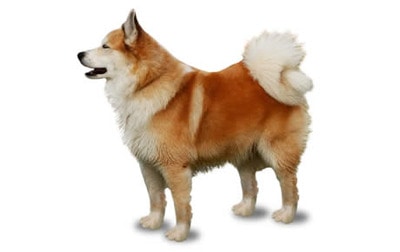Type the name of the breed you're looking for below
[wpdreams_ajaxsearchlite] Don't see the breed your're looking for? Click here and let us know!
Breed Characteristics
1 paw - breed exhibits the least amount of this characteristic
5 paws - breed exhibits most amount of this characteristic
Icelandic Sheepdog
| Other Names | Icelandic Spitz, Iceland Dog, Íslenskur fjárhundur, Islandsk Farehond, Friaar Dog, Canis islandicus |
| Country of Origin | Iceland |
| Weight | 20 - 30 lbs. (9 - 14 kg) |
| Height (at withers) | 12 - 16 in. (31 - 41 cm) |
| Coat | There are two types of coat, long and short, both thick and extremely weatherproof. |
| Colour | Tan, reddish-brown, chocolate, grey, black, with white as a required prominent colour. |
| Litter Size | 6 - 10 puppies, average 8 |
| Life Span | 11 - 14 years |
| Origin & History | The Icelandic sheepdog very much resembles dogs found in graves in Denmark and Sweden from about 8000 B.C. Dog imports to Iceland were limited and from 1901 even forbidden. In 1650 Sir Thomas Brown wrote "To England there are sometimes exported from Iceland ... a type of dog resembling a fox ... Shepherds in England are eager to acquire them!" Plague and canine distemper destroyed over 75% of the breed in the late 19th century, leading to a ban on the importation of dogs to Iceland. The purebred Icelandic sheepdog was again bordering extinction in the late 20th century and in 1969 the Icelandic Dog Breeder Association (HRFÍ) was established to preserve the breed, among other aims. The Icelandic sheepdog gained AKC recognition in June 2010, alongside the Leonberger and the Cane Corso. |
| Personality | Icelandic Sheepdogs are tough and energetic. It is a hardy and agile herding dog that barks, making it extremely useful for herding or driving livestock in the pastures, in the mountains or finding lost sheep. The Icelandic Sheepdog is, by nature, very alert and will always give visitors an enthusiastic welcome without being aggressive. Hunting instincts are not strong. The Icelandic Sheepdog is cheerful, friendly, inquisitive, playful and unafraid. Most adore children and get along well with other dogs and pets. Owners need to be consistent with the rules, calm but firm. They do best with some type of job to do. |
Care Requirements
| Health | There are no known breed-specific health concerns. |
| Grooming | The Icelandic Sheepdog has a double coat, thick and extremely weatherproof. There are two variants, Shorthaired: The outer coat is of medium length, fairly coarse, with a thick, soft undercoat. The hair is shorter on the face, top of head, ears and front of legs, longer on the neck, chest and back of thighs. The tail is bushy and the hair length is in proportion to the coat. Longhaired: The outer coat is longer than the above, fairly coarse, with a thick, soft undercoat. The hair is shorter on the face, top of head, ears and front of legs, longer behind the ears, on the neck, chest, behind the forelegs and back of thighs. The tail is very bushy and the hair length is in proportion to the coat. This breed does shed and normally blows its coat twice a year. It is important to trim the dewclaw nails regularly as because they have no contact with the ground, they can easily become too long. |
| Exercise | This is a very active breed that needs to be exercised every day. This breed needs to be taken on a daily walk or jog. While out on the walk make sure the dog heels beside or behind the person holding the lead, never in front, as instinct tells a dog the leader leads the way, and that leader needs to be the human. In addition, this breed will enjoy sessions of play. |
| Other Considerations | The Icelandic Sheepdog needs a lot of activity and exercise and needs close contact to the family. Many of these dogs have "home-alone anxiety" problems, because they don't like to be home alone. The breed is sometimes denoted in Latin as canis islandicus even though it is a breed and not a species. As the name implies, it is a sheep dog, but is also used as a watch dog and general working dog. When herding, the Icelandic sheepdogs were not mainly used to take the sheep from one point to another, but to prevent animals from straying. Additionally, the dogs were in charge of herding horses and other animals as well. When herding failed, the dogs drove the animals by barking. Thus, they tend to bark when they want something, although this behaviour can be controlled by training. In the Icelandic landscape, sheep often get lost and it has historically been the dog's job to find them and return them to the herd. They are therefore used to working on their own and to figuring things out for themselves, so owners have to beware lest they learn things they should not. As a watch dog, their main task was to alert the inhabitants when somebody was coming, so these dogs tend to bark a lot when they see people approaching. |



